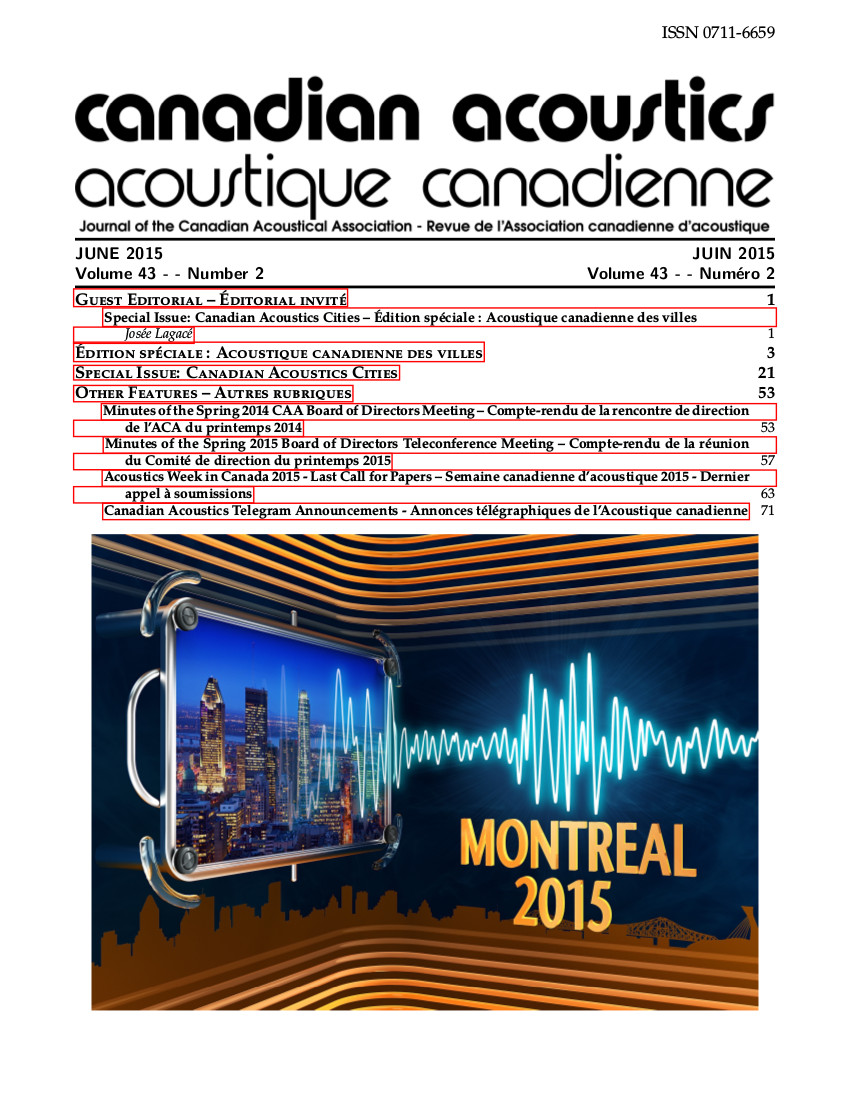Problématique entre les indices d’insonorisation du bâtiment, les interprétations et les règlementations aux niveaux local et canadien.
Keywords:
STC / FSTC / ASTC / ITS / IIC / FIIC / AIIC/ NISR / ISR / ASTM / E90 / E336 / E413 / E690 / E1007 / ISO / Building, Bâtiment / NBCC, CNB / CNRC-NRC / CMHC, SCHL / soundproofing, insonorisation / insulation airborne sound, isolation bruit aérien / insuAbstract
Au cours de la dernière décennie, les normes ASTM E336 et E1007 qui encadrent le mesurage et le calcul de l’indice d’insonorisation du bruit aérien et d’impact des cloisons au Canada ont substantiellement évolué et offrent de nouveaux indices plus fiables et plus adaptés à la réalité de l’évaluation des bâtiments. Bien que ces changements représentent une amélioration indéniable aux problèmes existants, ils introduisent aussi de nouveaux problèmes de correspondance avec les anciens indices et instaurent plusieurs problèmes d’interprétation professionnelle et juridique avec les diverses règlementations nationales et locales existantes. Cet article relate brièvement cette problématique et, à l’aube d’une refonte du Code national du bâtiment du Canada (CNB), amorce une réflexion ouverte sur une actualisation de documents de référence qui encadrera mieux une utilisation plus simple, plus claire et plus fonctionnelle pour le constructeur, le professionnel et le législateur.
During the last decade, ASTM E336 and E1007 standards that frame the measurements for estimating the insulation index of airborne and impact partitions in Canada have changed substantially and provide new clues that are more reliable and suitable for the reality of the assessment of building acoustics. Although these changes represent a clear improvement to the existing problems, it they introduce new correspondence problems with the old indexe and create several problems concerning professional and legal interpretation with the various existing national and local regulations. At the dawn at the dawn of an overhaul of the National Building Code of Canada (NBC), this article briefly describes the issue and, introduces (proposes) an open reflection on the updating of reference documents that will more efficiently frame the subject and will be easier to use, clearer and more functional for the builder, the professional and the legislator.
Additional Files
Published
How to Cite
Issue
Section
License
Author Licensing Addendum
This Licensing Addendum ("Addendum") is entered into between the undersigned Author(s) and Canadian Acoustics journal published by the Canadian Acoustical Association (hereinafter referred to as the "Publisher"). The Author(s) and the Publisher agree as follows:
-
Retained Rights: The Author(s) retain(s) the following rights:
- The right to reproduce, distribute, and publicly display the Work on the Author's personal website or the website of the Author's institution.
- The right to use the Work in the Author's teaching activities and presentations.
- The right to include the Work in a compilation for the Author's personal use, not for sale.
-
Grant of License: The Author(s) grant(s) to the Publisher a worldwide exclusive license to publish, reproduce, distribute, and display the Work in Canadian Acoustics and any other formats and media deemed appropriate by the Publisher.
-
Attribution: The Publisher agrees to include proper attribution to the Author(s) in all publications and reproductions of the Work.
-
No Conflict: This Addendum is intended to be in harmony with, and not in conflict with, the terms and conditions of the original agreement entered into between the Author(s) and the Publisher.
-
Copyright Clause: Copyright on articles is held by the Author(s). The corresponding Author has the right to grant on behalf of all Authors and does grant on behalf of all Authors, a worldwide exclusive license to the Publisher and its licensees in perpetuity, in all forms, formats, and media (whether known now or created in the future), including but not limited to the rights to publish, reproduce, distribute, display, store, translate, create adaptations, reprints, include within collections, and create summaries, extracts, and/or abstracts of the Contribution.


